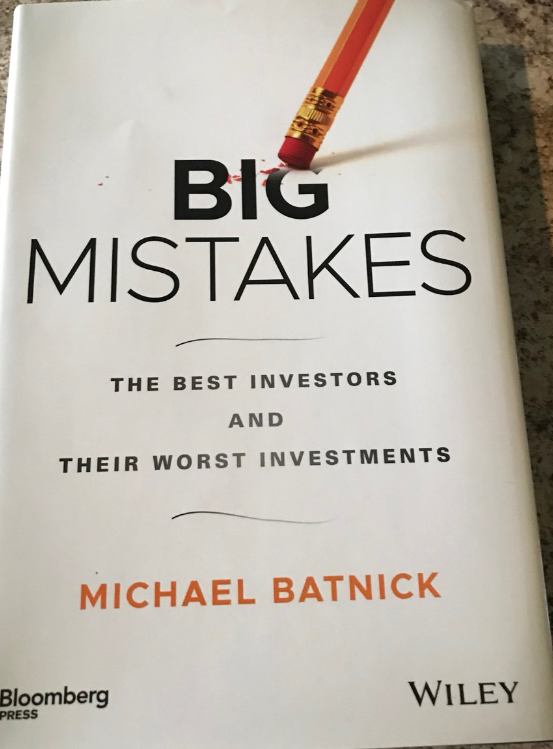
At the risk of sounding philosophical, cultivate a healthy sense of detachment from your portfolio and markets. Photo: Bloomberg
An inescapable facet of being a relative return fund manager is that your performance is always measured against a benchmark index. A layperson may not take it kindly if they are asked, “How’s your performance?” But we fund managers are quite used to the question and the words underperformance and outperformance, though not very common in everyday usage, are quite common in the money management lexicon.
Equally inescapable is the fact that every fund manager, however good, will go through phases of underperformance, i.e. their fund’s returns will be lesser than the benchmark index. The only known exception to this was possibly Bernie Madoff but we all know how that ended. Not even Warren Buffett has escaped this truth. In fact, he puts a simple table with Berkshire Hathaway’s per share book value growth and S&P index returns on the first page of every annual letter that he writes to shareholders. The 2017 letter shows that in six out of the past 10 years, Berkshire’s book value growth underperformed the S&P 500 and yet nobody would debate the fact that the cumulative return, both absolute and relative, over many decades has been astounding. However an average investment committee whose patience generally wears thin after a couple of consecutive years of underperformance would have sacked Buffett as a fund manager thrice in his career. Not having an investment committee breathing down his neck is perhaps Buffett’s biggest competitive advantage.
Lesser mortals though have to play this relative performance game and the unfortunate part is that index returns can be computed for all time periods from minutes to decades. I vividly recall a conversation with a fellow fund manager who was lamenting that he was already down 25 basis points against the index and it was only 10.30 in the morning.
Availability bias means that what’s measurable will be measured, irrespective of whether it is signal or noise. There are a few tell-tale symptoms of a fund manager who is underperforming even if it’s for a short period of time, like a few months. The first symptom is obsession with daily relative performance. Waking up bleary eyed to check this first thing in the morning is the most common sign. An extension of this is an unhealthy obsession with the performance of one’s peer group funds. Once done checking your own fund’s net asset value (NAV), you go through the NAV of your peer group funds to see if they are doing better or worse. This also morphs into obsession with peer group portfolios and who is buying or selling what.
Another symptom is to dissect index returns and focus too much on stocks that are in the index and have done well over the last few months. While being sure of why you don’t own a certain stock is important, spending too much time analysing stocks and sectors just because they have done well in the recent past will lead to biases. Shying away from investor communication is another sign. This is true not only for underperforming fund managers but also for companies which are going through a soft patch in their business cycle. All of us know of companies that are on multiple business news channels and investor roadshows when the going is good, but go into a shell when things turn for the worse. Loss of productivity due to fleeting attention span, given the pre-occupation with price movements and a constant state of irritability, that in an advanced stage leads to viewing everything negative through lens of a conspiracy theory are some of the other pitfalls.
The symptoms might seem formidable and yet you are not the first fund manager to exhibit them. Through self-observation and learning from seasoned investors who have seen these cycles multiple times, there are a few hacks to better contend with the symptoms. The one that helps most is knowing your investment style. Every fund manager should be able to clearly articulate in what kind of a market environment their style would work and when it wouldn’t. This should be mandatory material in every marketing pitch and should be emphasized, especially in the good times.
In times when the portfolio is underperforming the index, having this clarity can give tremendous confidence. Buffett alluded to this quite early in his investing journey. In his second annual letter to limited partners written in 1957, he said: “Our performance, relatively, is likely to be better in a bear market than in a bull market… In a year when the general market had a substantial advance, I would be well satisfied to match the advance of the averages.”
Rather than staring at the screen, a better use of time is to revisit the rationales you had written while buying the stocks in your portfolio and see if they are still valid. Engage with management teams again to ensure that your conviction still holds and weed out names where the original thesis is not playing out. Also, this should be a time when you pro-actively communicate with your investors and re-emphasize your style. It is important to know that your investors derive comfort from your confidence and getting into a shell in such times is detrimental.
Lastly, at the risk of sounding philosophical, cultivate a healthy sense of detachment from your portfolio and markets. This does not mean you abdicate responsibility but it means that you should be able to prevent the symptoms from taking over all your waking moments. All this is obviously easier said than done and this is much more a note to self rather than a sermon for anybody else. But if this helps a fellow investor cope with the symptoms even slightly better, it would have more than served its purpose.
Swanand Kelkar is managing director at Morgan Stanley Investment Management. These are his personal views. The article appeared on livemint.com and is available here.

So, you’ve missed the great bull market. But that isn’t as irritating as that of seeing the neighbour – whose IQ is close to room temperature – drive up in his third new Jaguar in as many years. You consider yourself a ‘value’ investor at a time when such concept seems to be totally discredited. Year after year, you expected – convincingly – that the great bull would crumble. But it hasn’t. You purchased gold and lost. You sold Amazon.Com short. You lost. You’ve missed out on Microsoft, Dell, Qualcomm, Intel, Cisco, Yahoo and the assorted Internet wannabes. You expected an end to the mania but it has not come. O.K., you’ve simply earned the right to be frustrated. But now what?
If, on the other hand, you are the bold and lucky fellow who loaded up on Cisco five years ago, your knees must be a little shaky as you stand at the Temple of Unrealized Gains. ‘This bull will go on’ you reason, but then you doubt yourself. You don’t know. You aren’t sure. You hear little voices, conflicting opinions; you see the volatility, the excess, the mania, and the mother of all bubbles staring you in the face – not to speak of a hefty capital gains tax lurking out there. So, what will it be?
What are we, investors, to do?
Let’s talk about it. But first, let us examine the great investment paradox. The making of a fortune, whether small or large, in one’s chosen profession is certainly a significant achievement. To put it aside for a rainy day, the next generation, or as a source of future income and financial security is also prudent and wise. But to preserve and manage this wealth is an endeavor far more difficult than that of making it in the first place. And this is the paradox.
Continue Reading →
Finance academics define risk as volatility, whereas value investors see risk as the probability that adverse outcomes in the future will permanently impair the business’s potential cash flow and investor’s capital. Which is correct? It all depends on your investment horizon. But if maximising terminal wealth is of importance to investors, and it is difficult to argue otherwise, then value investors have it right.
Let me explain.
There are two types of fundamental analysts: short-term and long-term. Short-term fundamental analysts are the typical financial analysts. They accept the stock price as given and try to determine what will make the stock price move. Their price targets and investment calls are affected by the release of short-term economic or corporate news. They react to such announcements.
Value investors are long-term fundamental analysts. They do not react to short-term announcements. For example, the short-term noise of whether the next quarter’s earnings deviate from expectations is immaterial. What is material for value investors is whether the company continues to have strong fundamentals, be well managed and financially sound, as well as “cheap.” The stock price is not important; instead, it is the difference between the intrinsic value and the stock price that is important. If the stock price is significantly below the intrinsic value (by a predetermined margin of safety), then the stock is considered cheap, and value investors buy. Otherwise, they wait.
Continue Reading →
Let me tell you the story of two investors, neither of whom knew each other, but whose paths crossed in an interesting way.
Grace Groner was orphaned at age 12. She never married. She never had kids. She never drove a car. She lived most of her life alone in a one-bedroom house and worked her whole career as a secretary. She was, by all accounts, a lovely lady. But she lived a humble and quiet life. That made the $7 million she left to charity after her death in 2010 at age 100 all the more confusing. People who knew her asked: Where did Grace get all that money?
But there was no secret. There was no inheritance. Grace took humble savings from a meagre salary and enjoyed eighty years of hands-off compounding in the stock market. That was it.
Weeks after Grace died, an unrelated investing story hit the news.
Richard Fuscone, former vice chairman of Merrill Lynch’s Latin America division, declared personal bankruptcy, fighting off foreclosure on two homes, one of which was nearly 20,000 square feet and had a $66,000 a month mortgage. Fuscone was the opposite of Grace Groner; educated at Harvard and University of Chicago, he became so successful in the investment industry that he retired in his 40s to “pursue personal and charitable interests.” But heavy borrowing and illiquid investments did him in. The same year Grace Goner left a veritable fortune to charity, Richard stood before a bankruptcy judge and declared: “I have been devastated by the financial crisis … The only source of liquidity is whatever my wife is able to sell in terms of personal furnishings.”
Continue Reading →

Michael Batnick’s new book, Big Mistakes: The Best Investors and Their Worst Investments came out this week.
There are far too many investing books that dissect the past successes of history’s greatest investors. These books make it easy for investors to assume emulating these greats should be effortless. I know that’s what I thought when I read about Buffett and Graham when I first started investing.
Most investors would be far better off trying to avoid mistakes than replicate their favorite billionaire’s track record. This book chronicles every mistake imaginable in the markets and it does so in a refreshing way by showing even the most intelligent among us screw up.
Here are six things I learned from the book:
Continue Reading →

“If you wake up thinking about a position, it’s too big” Steve Clarke
“Make your position size more a function of not how much you can make, but really how much you can lose. So manage your position based on your downward loss perspective not your upward potential.” James Dinan
“We will make something a large position if we think there is an extremely low chance of losing money on a permanent basis. Even if we think it might be a 4X return, if the idea could be a zero, it’ll be a small position” Ken Shubin Stein
“I’ll limit position sizes when potential outcomes are too binary” Chris Mittleman
“We do not bet the ranch on any single investment; few positions have exceeded 5% of assets in recent years” Seth Klarman
“We size things based on how much we think we can make versus how much we think we can lose. We’ll probably be willing to lose 5-6% of our capital in any one investment” Bill Ackman
Continue Reading →
Mention value investing and the phrase brings up different connotations for different people.
Some investors see value as a style as a dead regime, something stuffy old investors like Warren Buffett (Trades, Portfolio) live by, and their devout following of the strategy has cost them big time as they have missed out on some of the market’s best opportunities.

On the other hand, you have the devout value investors, those who remain fully committed to the strategy initially set out by Benjamin Graham and his partner David Dodd, all those years ago, even though this strategy has generated relatively lackluster returns over the past decade.
Continue Reading →

With so many articles dedicated to the debate on value stocks vs growth stocks I think it’s a good time to revisit what Seth Klarman calls ‘Value Pretenders’ in his best-selling book, Margin of Safety.
Here’s an excerpt from that book:
“Value investing” is one of the most overused and inconsistently applied terms in the investment business. A broad range of strategies makes use of value investing as a pseudonym.
Many have little or nothing to do with the philosophy of investing originally espoused by Graham. The misuse of the value label accelerated in the mid-1980s in the wake of increasing publicity given to the long-term successes of true value investors such as Buffett at Berkshire Hathaway, Inc., Michael Price and the late Max L. Heine at Mutual Series Fund, Inc., and William Ruane and Richard Cunniff at the Sequoia Fund, Inc., among others. Their results attracted a great many “value pretenders,” investment chameleons who frequently change strategies in order to attract funds to manage.
These value pretenders are not true value investors, disciplined craftspeople who understand and accept the wisdom of the value approach. Rather they are charlatans who violate the conservative dictates of value investing, using inflated business valuations, overpaying for securities, and failing to achieve a margin of safety for their clients. These investors, despite (or perhaps as a direct result of) their imprudence, are able to achieve good investment results in times of rising markets.
Continue Reading →

Today’s lesson is a virtual treasure trove of wisdom and insight from some of the best trading minds of all time. We are going to go on a journey of discovery and learn a little about some of the best traders ever and dissect some of their famous quotes to see what we can learn and how it applies to our own trading.
The way to learn anything is to learn from the greats, have mentors, teachers, study and read; you must make a concerted effort to absorb as much knowledge from the best in your field as possible, for that is truly the fastest way to success, be it in trading or any other field.
Below, you will find a brief introduction to 10 of the best traders of all time, followed by an inspiring quote from them and how I view that quote and apply it to my own trading principles. Hopefully, after reading today’s lesson you will be able to apply this wisdom to your own trading and start improving your market performance as a result…
George Soros
George Soros gained international notoriety when, in September of 1992, he invested $10 billion on a single currency trade when he shorted the British pound. He turned out to be right, and in a single day the trade generated a profit of $1 billion – ultimately, it was reported that his profit on the transaction almost reached $2 billion. As a result, he is famously known as the “the man who broke the Bank of England.”
Continue Reading →
If you question how ‘boring’ can be beautiful, you have been following the wrong investment strategy.
Too many people have the misconception that investing is glamorous. The reality is that glamour is the last thing you will find in the stock market, most especially if you plan on being successful.
Hedge fund guru, George Soros sums it up brilliantly: “If investing is entertaining, if you’re having fun, you’re probably not making any money. Good investing is boring.”
Sure, we have all heard of a stock market success story or two. You probably have an acquaintance who made a decent return from investing in a tech stock that tripled in price before selling. Maybe even someone who inadvertently timed the 2008-09 crash correctly. In most cases, these successes are short-lived and can be attributed to pure luck. Although these ‘successful investing’ stories make for good dinner-party conversation, they are by far the exception among prosperous independent investors.
The fact is investors who produce the flashiest returns, time and time again, usually do so in the most unglamorous manner. A great example is Warren Buffett, who built an empire investing in so-called ‘boring’ stocks.
Continue Reading →












